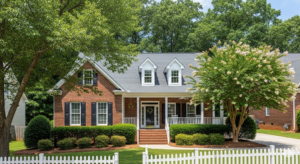Narrative
In 2022, the owners of a wedding venue in Gunter, Texas, undertook strategic tax planning to enhance their investment. The property consists of a newly constructed building designed for commercial use and improved with modern building systems and site enhancements. The structure was developed with high-quality materials and workmanship suited for long-term operation.
The property features durable interior and exterior finishes, upgraded lighting, mechanical systems, and custom improvements that support commercial functionality. Site elements include paved surfaces, landscaping, and related improvements that add value and utility to the overall property. Each component was evaluated as part of a detailed engineering-based cost review.
The owners engaged Engineered Tax Services (ETS) to perform a comprehensive cost segregation study of the property. This study aimed to identify and reclassify specific assets to accelerate depreciation and optimize tax benefits. This case study outlines the cost-segregation strategy employed and its significant impact on the property's financial outlook.
Objective
The primary objective of the cost segregation study was to identify and classify the commercial property’s assets within the $4,018,803 depreciable basis. By analyzing and reallocating building and site components into appropriate depreciation categories under MACRS, Engineered Tax Services (ETS) aimed to accelerate depreciation deductions and enhance the property owner’s overall tax savings and cash flow.
Methodology
ETS utilized a detailed engineering-based approach, including:
- Site Inspection: A physical inspection to document all structural, electrical, and land-improvement components.
- Document Review: Analysis of architectural plans, contractor invoices, and accounting schedules.
- Cost Analysis: Allocation of construction costs across building systems, site improvements, and personal property.
- Depreciation Calculation: Application of IRS Revenue Procedures, Tax Court rulings, and MACRS recovery periods to maximize allowable deductions.
Learn More About Cost Segregation
Explore the benefits of cost segregation and how it can enhance your property's profitability. Dive deeper into our strategies.
Asset Allocation
5-Year Class Life
Total Depreciation Allocation: $985,240 Percentage of Total Depreciable Basis: 24.5%
5-year class life assets identified in this study include:
- Short-lived tangible personal property used in operations
- Select electrical and mechanical components
- Movable interior fixtures and equipment
- Non-structural finish items and specialty improvements
15-Year Class Life
Total Depreciation Allocation: $1,230,570 Percentage of Total Depreciable Basis: 30.6%
15-year class life assets identified in this study include:
- Land improvements such as paving and exterior lighting
- Site features, including drainage, curbing, and irrigation systems
- Landscaping and other permanent site enhancements
39-Year Class Life
Total Depreciation Allocation: $1,803,000 Percentage of Total Depreciable Basis: 44.9%
39-year class life assets identified in this study include:
- Structural building components
- Foundation, framing, and roofing systems
- Permanent plumbing, electrical, and HVAC installations
- Walls, ceilings, and other integral parts of the structure
Class Life Details:
Summary
The cost segregation study for the commercial property in Gunter, Texas demonstrates the financial benefits of an engineering-based approach to asset classification. By identifying and reclassifying building and site components into shorter recovery periods, the study allowed for accelerated depreciation under the Modified Accelerated Cost Recovery System (MACRS), resulting in improved tax efficiency and cash flow for the property owner.
The analysis allocated $985,240, or 24.5% of the total depreciable basis, to 5-year property; $1,230,570, or 30.6%, to 15-year property; and $1,803,000, or 44.9%, to 39-year property. These allocations were determined through a detailed engineering review and reconciliation to the total project cost, ensuring compliance with IRS guidance and accepted cost segregation methodology.
This approach not only improved the property’s near-term tax position but also supported more efficient capital planning and reinvestment opportunities. The case study demonstrates how a detailed engineering-based cost segregation study can enhance the financial performance of commercial real estate, particularly for newly constructed properties with significant land improvements and building systems.
Unlock Your Tax Savings
Discover how cost segregation can maximize your tax benefits and improve cash flow. Get started today with a free consultation.



